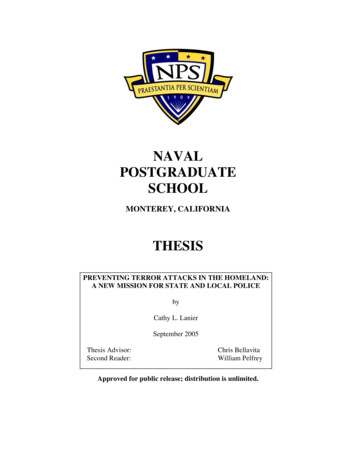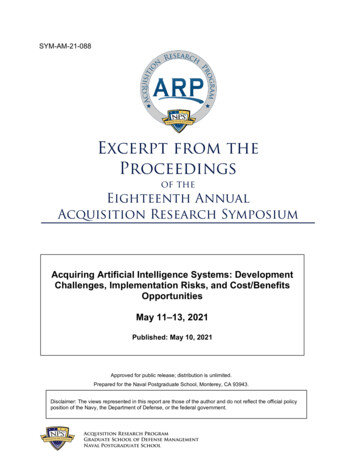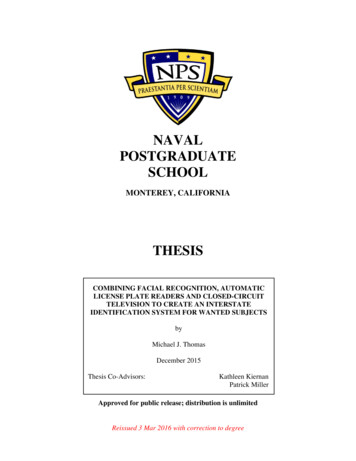
Transcription
NAVALPOSTGRADUATESCHOOLMONTEREY, CALIFORNIATHESISPREVENTING TERROR ATTACKS IN THE HOMELAND:A NEW MISSION FOR STATE AND LOCAL POLICEbyCathy L. LanierSeptember 2005Thesis Advisor:Second Reader:Chris BellavitaWilliam PelfreyApproved for public release; distribution is unlimited.
THIS PAGE INTENTIONALLY LEFT BLANK
REPORT DOCUMENTATION PAGEForm Approved OMB No. 0704-0188Public reporting burden for this collection of information is estimated to average 1 hour per response, includingthe time for reviewing instruction, searching existing data sources, gathering and maintaining the data needed, andcompleting and reviewing the collection of information. Send comments regarding this burden estimate or anyother aspect of this collection of information, including suggestions for reducing this burden, to Washingtonheadquarters Services, Directorate for Information Operations and Reports, 1215 Jefferson Davis Highway, Suite1204, Arlington, VA 22202-4302, and to the Office of Management and Budget, Paperwork Reduction Project(0704-0188) Washington DC 20503.1. AGENCY USE ONLY (Leave blank)2. REPORT DATESeptember 20053. REPORT TYPE AND DATES COVEREDMaster’s Thesis5. FUNDING NUMBERS4. TITLE AND SUBTITLE: Preventing Terror Attacks in the Homeland:A New Mission for State and Local Police6. AUTHOR(S) Lanier, Cathy L.7. PERFORMING ORGANIZATION NAME(S) AND ADDRESS(ES)Naval Postgraduate SchoolMonterey, CA 93943-50009. SPONSORING /MONITORING AGENCY NAME(S) AND ADDRESS(ES)N/A8. PERFORMINGORGANIZATION REPORTNUMBER10. SPONSORING/MONITORINGAGENCY REPORT NUMBER11. SUPPLEMENTARY NOTES The views expressed in this thesis are those of the author and do not reflect the officialpolicy or position of the Department of Defense or the U.S. Government.12a. DISTRIBUTION / AVAILABILITY STATEMENT12b. DISTRIBUTION CODEApproved for public release; distribution is unlimitedA13. ABSTRACT (maximum 200 words)As the Department of Homeland Security continues to develop plans and strategies to guide ourgovernment agencies towards a safer environment, state, local, and tribal law enforcement agencies are strugglingto define their role in the Homeland Security Mission. This paper proposes the creation of a National LawEnforcement Network made up of the state, local and tribal law enforcement agencies throughout the country. Thenetwork design will allow local agencies to reach beyond the traditional law enforcement approach by establishingformal networks that facilitate local, regional, national and eventually global coordination of an effective strategyaimed at preventing future terror attacks in the homeland.The creation of this network will ensure that every police officer in the United States understands theirrole in preventing future terror attacks. Drilling down to the lowest local level to include businesses, industry andthe private sector, the formation of the network expands our detection and prevention capabilities well beyond ourcurrent level.14. SUBJECT TERMSState, local, and tribal law enforcement terrorism prevention, intelligence requirements,threat detection17. SECURITYCLASSIFICATION OFREPORTUnclassified18. SECURITYCLASSIFICATION OF THISPAGEUnclassifiedNSN 7540-01-280-550015. NUMBER OFPAGES8116. PRICE CODE19. SECURITY20. LIMITATIONCLASSIFICATION OFOF ABSTRACTABSTRACTUnclassifiedULStandard Form 298 (Rev. 2-89)Prescribed by ANSI Std. 239-18i
THIS PAGE INTENTIONALLY LEFT BLANKii
Approved for public release; distribution is unlimitedPREVENTING TERROR ATTACKS IN THE HOMELAND:A NEW MISSION FOR STATE AND LOCAL POLICECathy L. LanierCommander, Metropolitan Police Department, Washington, D.C.Commanding Officer, Special Operations DivisionM.S., Johns Hopkins University, 2004Submitted in partial fulfillment of therequirements for the degree ofMASTER OF ARTS IN SECURITY STUDIES(HOMELAND SECURITY AND DEFENSE)from theNAVAL POSTGRADUATE SCHOOLSeptember 2005Author:Cathy L. LanierApproved by:Christopher BellavitaThesis AdvisorWilliam PelfreySecond Reader/Co-AdvisorDouglas PorchChairman, Department of National Security Affairsiii
THIS PAGE INTENTIONALLY LEFT BLANKiv
ABSTRACTAs the Department of Homeland Security continues to develop plans andstrategies to guide our government towards a safer environment, state, local, and triballaw enforcement agencies are struggling to define their role in the Homeland SecurityMission. This paper proposes the creation of a National Law Enforcement Network madeup of the state, local and tribal law enforcement agencies throughout the country. Thenetwork design will allow local agencies to reach beyond the traditional law enforcementapproach by establishing formal networks that facilitate local, regional, national andeventually global coordination of an effective strategy aimed at preventing future terrorattacks in the homeland.The creation of this network will ensure that every police officer in the UnitedStates understands their role in preventing future attacks. Drilling down to the lowestlocal level to include businesses, industry and the private sector, the formation of thenetwork expands our detection and prevention capabilities well beyond our current level.v
THIS PAGE INTENTIONALLY LEFT BLANKvi
TABLE OF CONTENTSI.INTRODUCTION.1A.PROBLEM .11.Framing the Issues: Whose Job is it Anyway?.22.The Current Situation .43.Progress Toward an Efficient System .5B.DEFINING THE STRATEGIC ISSUES: CONFUSION REMAINS .61.Funding .8C.METHODOLOGY .10II.CHALLENGES.13A.PERCEPTIONS AND THREATS .131.Understanding the Threat.13B.TRANSITION TO FOURTH GENERATION TACTICS .141.Islamic Fundamentalist .142.Growing Domestic Threats .163.The Patriot Movement.164.Networks Expanding .17III.EMPHASIZING PREVENTION .19A.IDENTIFYING INDICATORS.19B.STRATEGIC AND TACTICAL PREVENTION .191.Detection: A Strategic Focus.202.Deterrence – Tactical Focus.20C.UNDERSTANDING THE TERRORIST CONTINUUM.21D.OPPORTUNITIES MISSED .251.The 1993 World Trade Center Bombing & Holland TunnelPlot.252.1995 Attack on the Alfred P. Murrah Building, Oklahoma City .263.The 2001 Attack on the World Trade Center and Pentagon .28E.A CLEAR ROLE FOR LOCAL LAW ENFORCEMENT.301.The Discoverers.31IV.PUBLIC POLICY AND PUBLIC VALUE .35A.NATIONAL AND LOCAL CHALLENGES .351.National Level: National vs. Local Priorities .352.Local Level: Changing Perceptions.36B.CONSIDERATIONS .37V.BUILDING THE LAW ENFORCEMENT STRATEGY.39A.EXPANDING THE MISSION.391.Community Oriented Policing and Today’s Strategy .392.Leveraging Existing Expertise .40VI.THE ROAD MAP .43vii
A.B.C.D.E.VII.ESTABLISHING NATIONAL STRUCTURE .431.The Principles.43MISSION SPECIFIC CLUSTERS .441.The System.44EFFECTIVE NETWORKS .461.Establishing Local Intelligence Requirements .462.National Intelligence and Criminal Intelligence .473.Intelligence for Prevention and Planning .474.Use of Intelligence and Technology .48EXTERNAL NETWORKS.491.Existing Programs.492.Terrorism Prevention Outreach Programs .503.The Terrorism Early Warning Group (TEW).504.Expanding Local Programs through the Network .50NATIONWIDEIMPLEMENTATIONOFPREVENTIONPROGRAMS .511.Creating Regional Fusion Centers .522.Connecting at the National and Global Level .52CONCLUSIONS S .53B.PREVENTION AND FUNDING.53C.IMPROVING INTELLIGENCE AND COMMUNICATION.54D.LEADING AND IMPLEMENTING CHANGE .541.The Homeland Security Strategic Cycle for SLTLE .55VIII. STRATEGIC POLICY DOCUMENTS .59A.NATIONAL STRATEGY .59B.LOCAL AND REGIONAL OPERATIONAL POLICIES .59C.INCENTIVES.59D.IMPLEMENTATION MODEL .60LIST OF REFERENCES .61INITIAL DISTRIBUTION LIST .65viii
LIST OF FIGURESFigure 1.Figure 2.Figure 3.Figure 4.Figure 5.The Terrorist Attack Continuum.22Activity Detection Areas.24National Law Enforcement Network: Mission Specific Clusters.45The National Prevention Network .51Homeland Security Strategic Preparedness Cycle for NLEN.56ix
THIS PAGE INTENTIONALLY LEFT BLANKx
LIST OF ABBREVIATIONS/ACRONYMSCIACentral Intelligence AgencyCFRCode of Federal RegulationsDNIDirector of National IntelligenceDoDDepartment of DefenseFBIFederal Bureau of InvestigationsHLSHomeland SecurityICIntelligence CommunityJTTFJoint Terrorism Task ForceLBNLocal Business NetworkMSCMission Specific ClustersNLENNational Law Enforcement NetworkSLTLEState, local, tribal law enforcementTIPPTerrorist Incident Prevention ProgramTEWTerrorism Early WarningUSCUnited States Codexi
THIS PAGE INTENTIONALLY LEFT BLANKxii
ACKNOWLEDGMENTSFirst and foremost I want to acknowledge my mother, Helen, who through herstrength, support and unbelievable patience, has helped me more than any other. Herkindness and selfless dedication to her family has made life a fabulous expedition. Thereare not words to describe how much I love and admire all she has accomplished.Although it is impossible to thank all of those who have influenced my continueddrive to accomplish something useful for the law enforcement profession over the past 15years, there are a few that deserve special recognition. To Chief Sonya Proctor, ChiefRoss Swope, Dr. Phyllis McDonald, Dr. Shelly Greenberg, and Prof. ChristopherBellavita, my sincerest thanks for sharing your brilliance with me despite the enormouscompeting demands for your time.To Chief Charles Ramsey, I express my deepest appreciation for your continuedsupport and encouragement during my career and the development of this project.Without your insight, thoughtfulness, and advice, I would not have made this wonderfuljourney. I will carry your wisdom with me every day.I also need to acknowledge my colleagues in the MPD as my success would nothave been possible without them. I have been blessed with the opportunity to work withthe finest men and women my profession has to offer. To Patrick, Carolyn, Ralph, Jeffand Frank, who have become my second family, I offer my sincerest gratitude for yourtireless efforts to keep me going when it didn’t seem possible.Finally, I must thank a number of academic and professional colleagues that havecontributed to my work by sharing their expertise and friendship throughout thisendeavor. To Chief Joe Pfeifer, Chief Pat Miller and Agent Greg (GB) Jones, you haveprovided me with your invaluable knowledge, encouragement and sincere friendship thatmade each step an adventure and for that, I am eternally grateful.In closing, I would like to dedicate this thesis to those first responders who losttheir lives doing what they were driven to do on September 11, 2001. It is their sacrificethat drives the rest of us to do what we can to prevent this from ever happening again.xiii
THIS PAGE INTENTIONALLY LEFT BLANKxiv
I.A.INTRODUCTIONPROBLEMWith all of the talk about “connecting the dots”1 there has been little focus onhow to identify the “dots” in the first place. After all, the dots, (or bits and pieces ofinformation), that may be linked to terrorist activity can be very subtle and are oftendifficult to identify. While it is not complicated to identify and assemble known bits andpieces of information after an attack has occurred, it is seldom that simple before theevent. The ability to recognize the links between unusual behavior, or subtle activities,and potential preparation for a terrorist attack can be extremely difficult; especially forfederal intelligence agencies that have the responsibility of scanning the globe forpotential threats. While most agree it is reasonable to hold federal intelligence agenciesaccountable for analyzing and connecting the dots, it is unrealistic to think they will beable to identify all of them. Preventing future terror attacks will not be possible withoutan effective system for collecting and connecting the important bits and pieces ofinformation needed to identify and stop terrorists before they strike. Today’s terrorism isa local crime and with the potential for future attacks increasing, it is essential that weengage the more than 800,000 state, local and tribal police officers that work in our localcommunities in strategic prevention activities that will assist them with identifying thosedots.The ability to recognize this type of behavior or subtle activity requires a balanceof knowledge, familiarity, experience and skill; all of which have been mastered bypolice officers when it comes to dealing with traditional crime. Local law enforcementhas the structure, systems, skills and performance metrics already in place to understandand deal with traditional crime and they are eager to be included in the HomelandSecurity Mission. Preventing terror attacks must be viewed as a priority in the HomelandSecurity Mission and leaving local law enforcement out of the national preventionstrategy is no longer a defendable option.1 “Connecting the dots” refers to the intelligence community’s ability to relate important pieces ofinformation through analysis and identify potentially dangerous or threatening activity or patterns ofactivity.1
In today’s environment we must consider strategies that will allow us to defendour nation from terrorists who operate in increasingly diverse networks and are skilled atblending among us as they plan and carry out asymmetric attacks in our localcommunities; a concept we have still not been able to come to grips with as a nation.Despite numerous and progressively more deadly attacks2 within the United States, weare still a nation of confidence, comfort and complacency when it comes to ourvulnerability to future attacks. However, the reality is that terrorists will continue tolaunch attacks in the United States and our government has an obligation to do everythingwithin its power to protect our citizens by improving our ability to identify the importantand sometimes subtle, bits and pieces of information that may prevent an attack before itoccurs.With the growing need for global situational awareness, most agree thatconnecting the dots should remain the responsibility of the federal intelligence agencies,which have years of experience and the resources available to analyze intelligence;however, domestically, it is the local police officers who are on the front lines interactingwith hundreds of thousands of individuals and businesses each day that will be the oneswho discover most of them.1.Framing the Issues: Whose Job is it Anyway?There are mixed messages being sent when it comes to who is actually supposedto do what in the Homeland Security Mission and confusion remains about who will beheld accountable for what.In the aftermath of the 9-11 attacks there was a whirlwind of controversysurrounding our nation’s ability to detect and respond to such a devastating attack thathad literally been planned in our own backyard. While the Department of Defense,federal intelligence agencies and elected leaders underwent round after round of criticismfor failing to recognize the increasing threat posed by terrorists, local police leaders were2 Bruce Hoffman, Terrorist Targeting: Tactics, Trends, and Potentialities, in Technology andTerrorism, ed., Paul Wilkerson (Portland, Oregon: Frank Cass, 1993), 21. See also “Current and ProjectedNational Security Threats to the United States,” Vice Admiral Lowell E. Jacoby, U.S. Navy, Director,(Defense Intelligence Agency, February 2005).2
taking advantage of this rare opportunity to emphasize the impact of being ignored as thefirst responders to acts of terrorism.3But given this opportunity, local law enforcement leaders did not stress (or maybedid not even realize) how critical a role they play in detecting and deterring terroristactivities and preventing attacks. After all, no one blamed police officials for failing tounderstand the threat or questioned why hundreds of thousands of police officersengaging in community policing4 and criminal investigations every day never detectedthe presence of the 9-11 operators who had been living in and preparing for the attacks inthe communities officers were sworn to protect.Given the benefit of hindsight, one can’t help but wonder if things would bedifferent for police officers today if the 9-11 Commission had questioned police leadersabout why their officers didn’t know the terrorist were operating in their community?What if police chiefs had been asked how much time they had invested in training theirofficers to recognize potential indicators of terrorist activity prior to 9-11? It seemsreasonable that things would be different had these issues been raised in 2001; just as it islikely that these questions will be raised in the aftermath of the next attack.Raising this issue is not meant to criticize police leaders for actions in past events,but more to bring attention to the critical gaps in our National Homeland SecurityStrategy that may bring harsh criticism in the future. While it can be assumed that locallaw enforcement leaders had at least some indication that terrorists continued to pose athreat to the United States following the attacks on the World Trade Center in 1993 andthe Alfred P. Murrah Building in 1995; I would suggest that the reason police leaders didnot pursue terrorist-related training and preparation more aggressively had more to dowith understanding their role than it did with understanding the threat. Until recently,counter-terrorism had always been viewed as a federal responsibility, not a local one;which made sense in the past when the primary terrorist threat came from state actors3 A. Chambers, “Terrorism’s Cost Hit Home,” Illinois ay/terrorism.html]. August 13, 2005.May2002.4 Community policing is a term commonly used to describe a method of deploying police officers tofixed geographical areas to enhance their relationship with members of the community. The goal ofcommunity policing is to promote pro-active problem solving and crime prevention through policecommunity partnerships.3
who threatened us from afar. But it does not make sense today, as it is clear that theprimary threat of future terror attacks comes from decentralized terror cells that existwithin our borders. Counter-terrorism can no longer be viewed as a federal responsibilityand local law enforcement leaders must adapt and broaden their expertise beyondresponse.Unfortunately, this mentality is not new for Americans and is certainly not limitedto the law enforcement community. In general, Americans still feel that the FBI, CIA andthe Department of Defense are responsible for defending the homeland and preventingterrorist attacks, so much so that the FBI was publicly criticized after 9-11 for choosing to“serve local priorities, not national priorities.”5The lack of support for local law enforcement when it comes to counter-terrorismcontinues to present a challenge for law enforcement leaders who understand theimportance of their role in preventing future attacks.2.The Current SituationOn July 16, 2002, President George W. Bush wrote in his opening letterannouncing the National Strategy for Homeland Security; “This is a national strategy, nota federal strategy.”6 The strategy itself supports this idea by reinforcing that the goal ofthe National Strategy for Homeland Security was designed to be “a concerted nationaleffort to prevent terrorist attacks within the United States, reduce America’s vulnerabilityto terrorism and minimize the damage and recover from attacks that do occur.”7Since that time the Department of Homeland Security has produced more than adozen documents to build on that concept through the release of the National ResponsePlan, the National Incident Management System, the National Preparedness Goals andnumerous other “how to” manuals. However, these documents and the overall concept ofhomeland security still remain primarily a federal effort to support a federal strategy.Despite everyone’s best efforts, the strategy and the idea of homeland security, has yet to5 National Commission on Terrorist Attacks Upon the United States: The 9/11 Commission Report(New York: W.W. Norton & Company, 2004), 74.6 Office of Homeland Security, National Strategy for Homeland Security, Letter to the AmericanPeople, July 16, 2002, Office of Homeland Security (Washington, D.C.: Government Printing Office,2002), 4.7 Ibid., 2.4
evolve into a concerted national effort that includes key players at the local level.8Although an overarching concept of operations for protecting our homeland has beenarticulated, constructing a framework for national coordination will require significanttransformation of long-standing perceptions and traditions that present challenges toaccomplishing this goal.It is clear that the President’s intention was to create an efficient “system” thatincludes the use of federal, state and local governments as well as private security toprevent, deter and respond to terror attacks within the United States; however, we are stillstruggling to break away from the traditional independent systems that are entrenched inour government. Despite the significant internal improvements made within eachdiscipline over the past few years, each continues to operate independently when it comesto prevention, deterrence and response. Therefore this paper will propose an effectivemethod for integrating the state, local and tribal law enforcement (SLTLE) componentinto the larger Homeland Security “system” envisioned by the President when theNational Strategy was developed.3.Progress Toward an Efficient SystemThe idea to create the Department of Homeland Security was based on theconcept that there must be a unified effort within the primary disciplines before acoordinated strategic effort could be effectively implemented. This effort began with theintegration of 22 domestic security related agencies under the Secretary of theDepartment of Homeland Security in 2002.9 The evolution continued in 2004 when theDirector of National Intelligence was appointed to coordinate the efforts of the 14agencies that make up the nation’s intelligence community.10 However, there has been nosuch effort to coordinate the work of more than 18,000 SLTLE agencies.It is clear that there is still much to be done in the way of creating efficientnational systems within each of the disciplines before a truly unified national effort to8 IACP, “From Hometown Security to Homeland Security: Principles for a Locally Designed andNationally Coordinated Homeland Security Strategy,” Report to the Department of Homeland Security(2005), 2.9 Homeland Security Act of 2002 (6 U.S.C. 101), November 25, 2002.10 The Director of National Intelligence is a Cabinet level position created in February, 2005 (50 USC.403-1).5
prevent and respond to terrorism can begin. If critical assets in the key sectors remaindisjointed and without the structure needed to ensure a smooth transition into the largernational homeland security system we will once again find ourselves explaining why wefailed to connect the dots after the next attack. Therefore the effort must begin with astructure that will synchronize the work of the agencies within each discipline andprovide them with a common understanding of their mission.B.DEFINING THE STRATEGIC ISSUES: CONFUSION REMAINSThe National Strategy loosely defines law enforcement’s role as one of“preventing and interdicting terrorist activity within the United States,”11 but the lack ofclarity and guidance has resulted in some significant strategic issues for the SLTLEleadership.The first deals with the continued emphasis on response. While purchasingpersonal protective equipment and response vehicles are important elements of ourpreparedness, this approach suggests that we are helpless to prevent future attacks andsends a clear message to society that the only role of police officers is to respond to anddeal with the aftermath of the next attack. This is a disturbing mindset in light of what wehave learned about the obvious indicators that were missed in the weeks and monthsleading up to the 9-11 attacks.The second is our national focus on preparing only those agencies in the largestmost densely populated cities, essentially ignoring the role of nearly 80% of the policeagencies in the United States.12 Although there is clearly a need to consider the likelihoodof another attack on a major U.S. city, focusing solely on response capabilities in ourmost populated cities ignores the role of many smaller agencies in detecting the subtlebehaviors and activities that may be associated with terrorists preparing for an attack. Italso ignores the potential for smaller attacks against soft targets in areas outside of themajor cities within the United States.13 These are important gaps considering what is11 Office of Homeland Security, “National Strategy for Homeland Security” (July 2002), 25.12 The average police department in the United States has 25 or fewer sworn police officers.13 Targets such as amusement parks, stadiums, transportation systems, schools, or remote criticalinfrastructure are just a few examples of potential targets located in rural areas outside of major cities that ifattacked could create a sense that no one is safe; maximizing the primary goal of the terrorists.6
known about how terrorists target, gather resources and prepare for attacks. One onlyneeds to pay attention to the attacks that continue to take place around the world torealize that soft targets are becoming increasingly attractive to terrorists who are efficientat exploiting our vulnerabilities. The openness of the American society combined withthe network capabilities of terrorists and the ease of transportation does not limitterrorists to large urban areas within the United States. While terrorists may target largeurban areas, they can mobilize, plan, secure resources and then deploy fro
As the Department of Homeland Security continues to develop plans and strategies to guide our government agencies towards a safer environment, state, local, and tribal law enforcement agencies are struggling . NAVAL POSTGRADUATE SCHOOL September 2005 Author: Cathy L. Lanier Approved by: Christopher Bellavita Thesis Advisor William Pelfrey










